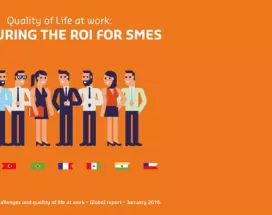Discover how reimagining traditional lunch breaks, building friendships at work, and creating shared moments for relaxation can enhance team cohesion in today's decentralised work environment. This blog explores the importance of social interactions, wellness, and bonding, offering practical strategies to navigate the evolving world of work successfully.
Companies spend about $8 billon a year on wellness plans – but are they really worth it. Two experts, Jim Purcell, a leading U.S. consultant on wellness, and Bénédicte Lepère, Global SVP of HR at Sodexo Benefits and Rewards Services, discuss the components of successful wellness programs and weigh out the benefits.
Stress is a familiar, and costly, problem in the modern workplace. But how can it be reduced - for the benefit of employees and employers alike? Feel-Good management, which focuses on people’s happiness at work, could be the answer. Stress is probably the most widely understood malaise of the modern workplace, blighting the lives of hundreds of millions of workers around the world. What’s been much less understood is how to deal with it. Now, however, the rise of ‘Feel-Good management’ offers a new answer to a longstanding problem.
There may not be many win-wins in business today, but helping employees to protect the environment and lower a company’s utility bills has to be one of them. Green issues are capturing more of the public’s attention, while sustainability is rapidly moving up the business agenda under the heading of Corporate Social Responsibility.
For many people, work is a source of enjoyment and personal satisfaction, and an important part of a generally happy life.
With most workplaces becoming increasingly competitive, employees are prone to various health-related issues. Poor work-life balance, deadlines, combined with a lack of stress management knowhow, and unhealthy eating habits have been identified as some of the key causes of the corporate workforce's deteriorating health.
It is very tough for people to maintain a healthy work-life balance for a number of reasons. With so many people stuck between heavy workload, maintaining relationships and family responsibilities, it’s no surprise that people are spiraling into a rather unhealthy lifestyle.
The view that most employees are less engaged with their careers after they become parents is widely held in today's workplace and has only one major drawback. It's not true.
Employees have long been victims of corporate globalization and as a result, standardization of working conditions. But now, with flex offices, new work from home practices, and new types of jobs, personalization is gaining ground. Soon, there will be as many ways of working as there are employees.
It is always 12.30 pm somewhere in the world; every second, lunch breaks at work are starting in some part of the planet. But over the last decade, they have become increasingly shorter, been skipped, or spent in front of a screen. This is true today more than ever, in the work from the age where employees are hooked to their screens from morning to evening without taking the necessary breaks. It is indisputable that the time devoted to the famous lunch break is evaporating as the years go by, all around the world.
The digital payment space and Fintech industry have grown tremendously with the pandemic pushing more transactions towards contactless. The use of digital platforms for day-to-day activities such as buying meals & groceries, mobile recharges, etc. witnessed an increase as most people preferred to stay home and maintained social distancing. Digital payments systems continued to receive focus from the government as the Reserve Bank Of India (RBI) released ‘Digital Payments Index (DPI)’, a new index to measure digital payments growth in India.
What started over a year ago has now become the ‘New Normal’. The pandemic altered how everyone functioned and significantly impacted workplace management. From people heading to work every day pre-pandemic, more and more employees are settling into a home-office routine now.
Quality of Life at work: measuring the ROI for SMEs
The shift to work-from-home has brought a lot of challenges for employees – be it tighter finance management, lack of socialization with colleagues, less travel due to restrictions, and much more. As a result, organizations must focus more on the holistic wellness of employees and to help maintain the balance between professional and personal lives. Furthermore, as offices are steadily opening and employees are getting back, they expect their employers to be more focused on their health to get access to the best care. They also want access to information and resources that help them manage and improve their health and well-being on a regular basis.
Taking note of that, various organizations are charting out key strategies for the year ahead. In the wake of the current needs and demands, Sodexo BRS India, hosted a webinar on “How to Improve Employees’ Quality of Life through Smart Wellness Programs'' with Ms. Simran Oberoi, HR Advisor on Diversity & Inclusion and TEDx speaker on holistic wellness. Let us decode some important insights from the webinar on How Agile, Tech-First and Inclusive Wellness Programs can help improve the Quality of Life of Employees.
Competing against products and services from much larger companies comes with the territory for Small and Medium-sized Enterprises. But should they also try to match big firms when it comes to parental policies? All the evidence suggests that SMEs can gain tangible benefits from supporting employees who have to juggle a career with raising a family.















